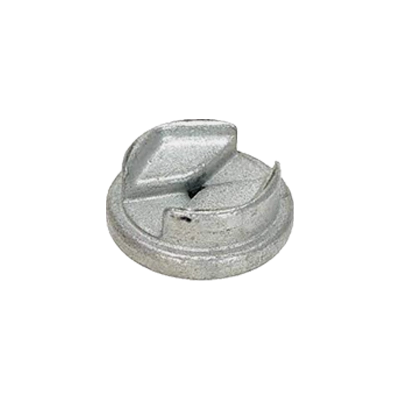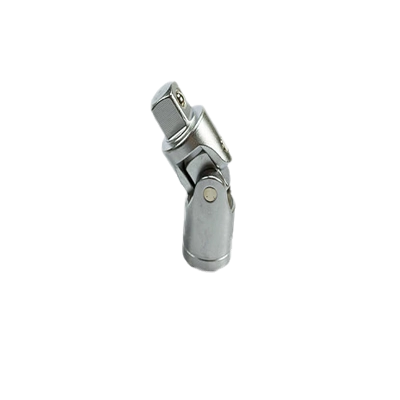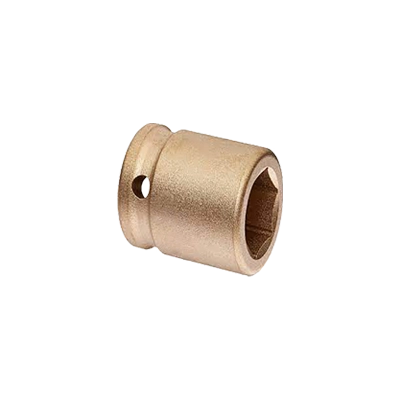Call +(254) 703 030 000 / 751 483 999 / 721 704 777
- Home
- Tools
- Sockets Bits
- Sockets Sets
- Sockets
.....Read More
Frequently Asked Questions
What are the different types of sockets used in manual drive tools?
The different types of sockets used in manual drive tools include:
1. **Standard Sockets**: These are the most common type, used for general purposes. They come in both metric and SAE (Society of Automotive Engineers) sizes to fit various bolt and nut sizes.
2. **Deep Sockets**: Designed to reach nuts on long bolts or threaded rods, deep sockets have a longer body compared to standard sockets.
3. **Impact Sockets**: Made from thicker, more durable materials, impact sockets are designed to withstand the high torque of impact wrenches. They are typically black due to a protective coating.
4. **Universal Joint Sockets**: These have a flexible joint that allows the socket to pivot, making it easier to reach fasteners at awkward angles.
5. **Spark Plug Sockets**: Specifically designed for removing and installing spark plugs, these sockets often have a rubber insert to protect the plug.
6. **Hex Bit Sockets**: These combine a hex bit with a socket, used for driving screws and bolts with hexagonal recesses.
7. **Torx Bit Sockets**: Similar to hex bit sockets, but designed for Torx screws, which have a star-shaped recess.
8. **Swivel Sockets**: These have a built-in swivel joint, allowing for greater flexibility and access in tight spaces.
9. **Pass-Through Sockets**: These allow a bolt or threaded rod to pass through the socket, useful for long bolts where a standard socket would not fit.
10. **E-Torx Sockets**: Designed for external Torx bolts, these sockets have a star-shaped internal profile.
11. **Flex Sockets**: These have a flexible joint that allows the socket to bend, providing access to hard-to-reach areas.
12. **Thin Wall Sockets**: Designed with a thinner wall to fit into tight spaces where standard sockets cannot.
Each type of socket is designed for specific applications, ensuring the right fit and function for various tasks.
How do I choose the right socket for a specific application?
1. **Identify Application Requirements**: Determine the electrical specifications such as voltage, current, and power requirements. Consider the environment (indoor, outdoor, wet, dry) and any specific standards or certifications needed.
2. **Socket Type**: Choose between AC or DC sockets based on the power source. For AC, consider the plug type (e.g., Type A, B, C) compatible with the region.
3. **Current and Voltage Rating**: Ensure the socket can handle the maximum current and voltage of the application. Overrating is safer to prevent overheating.
4. **Material and Durability**: Select materials that withstand environmental conditions. For outdoor or industrial use, consider weatherproof or ruggedized sockets.
5. **Mounting Style**: Decide between panel mount, surface mount, or flush mount based on installation requirements.
6. **Safety Features**: Look for features like grounding, surge protection, and child safety shutters if applicable.
7. **Compatibility**: Ensure the socket is compatible with the plug and device connectors. Consider future-proofing for potential upgrades.
8. **Size and Space Constraints**: Check the physical dimensions to ensure it fits within the designated space.
9. **Cost and Availability**: Balance between cost and quality. Ensure the socket is readily available for replacements or repairs.
10. **Regulatory Compliance**: Ensure compliance with local electrical codes and standards (e.g., UL, CE).
11. **Aesthetic and Design**: For visible installations, consider the design and color to match the environment.
12. **Brand and Reliability**: Choose reputable brands known for quality and reliability to ensure long-term performance.
13. **User Feedback and Reviews**: Research user reviews and feedback for real-world performance insights.
14. **Consultation**: If unsure, consult with an electrical engineer or professional for advice tailored to your specific application.
What is the difference between all-purpose sockets and specialty automotive sockets?
All-purpose sockets are designed for general use across a wide range of applications. They typically come in standard sizes and are made from durable materials like chrome vanadium steel. These sockets are versatile and can be used for various tasks, such as household repairs, furniture assembly, and basic automotive work. They are usually part of a socket set that includes a range of sizes and drive types, such as 1/4-inch, 3/8-inch, and 1/2-inch drives.
Specialty automotive sockets, on the other hand, are specifically designed for automotive applications. They often feature unique designs or materials to handle the specific demands of vehicle maintenance and repair. For example, impact sockets are made from thicker, more robust materials to withstand the high torque of impact wrenches. They are typically black due to a protective coating that prevents corrosion. Other specialty automotive sockets include spark plug sockets, which have a rubber insert to protect the spark plug, and oxygen sensor sockets, which have a cutout to accommodate the sensor's wiring.
The key differences lie in their design, material, and intended use. All-purpose sockets are more versatile but may not withstand the high demands of automotive work. Specialty automotive sockets are tailored for specific tasks, offering better performance and durability in automotive settings. Using the appropriate socket type ensures efficiency and reduces the risk of damage to tools or vehicle components.
How do bolt extraction sockets work to remove stuck fasteners?
Bolt extraction sockets work by providing a secure grip on stuck fasteners, allowing for their removal. These sockets are designed with reverse spiral flutes or aggressive internal teeth that dig into the fastener's surface as torque is applied. When a bolt or nut is rounded, corroded, or otherwise damaged, traditional tools like wrenches or sockets may slip. Extraction sockets counter this by increasing friction and grip.
The process begins by selecting a socket size that fits snugly over the damaged fastener. The socket is then placed onto the fastener, and a ratchet or breaker bar is attached to the socket's drive end. As the tool is turned counterclockwise, the socket's internal design bites into the fastener, creating a strong mechanical bond. This bond allows the user to apply significant torque without slipping, effectively loosening the fastener.
Some extraction sockets are designed to work with both metric and SAE sizes, providing versatility. They are typically made from hardened steel to withstand the forces involved in removing stubborn fasteners. Additionally, some sets include a range of sizes to accommodate various fastener dimensions.
In cases where the fastener is severely corroded or seized, penetrating oil may be applied beforehand to aid in loosening. The combination of the socket's grip and the lubricant can increase the chances of successful extraction. Once the fastener is removed, the socket can be easily detached, ready for reuse on another project.
What are the benefits of using insulated sockets?
Insulated sockets offer several benefits, particularly in enhancing safety and efficiency in electrical work:
1. **Electrical Safety**: Insulated sockets are designed to protect users from electric shocks. The insulation prevents accidental contact with live electrical components, reducing the risk of injury.
2. **Durability**: The insulation material often adds an extra layer of protection against wear and tear, making the sockets more durable and long-lasting.
3. **Heat Resistance**: Insulated sockets can withstand higher temperatures, which is beneficial when working in environments where heat is a factor, preventing damage to the tool and ensuring user safety.
4. **Corrosion Resistance**: The insulating material often provides resistance to corrosion, which is particularly useful in environments exposed to moisture or chemicals, extending the life of the tool.
5. **Improved Grip**: The insulation often provides a better grip, reducing the likelihood of the tool slipping during use, which enhances precision and safety.
6. **Compliance with Standards**: Many insulated sockets meet industry safety standards, ensuring that they are suitable for professional use and providing peace of mind to users.
7. **Versatility**: Insulated sockets can be used in a variety of applications, including automotive, industrial, and residential electrical work, making them a versatile addition to any toolkit.
8. **Reduced Risk of Short Circuits**: By preventing accidental contact with conductive parts, insulated sockets help reduce the risk of short circuits, protecting both the user and the equipment.
9. **Enhanced Performance**: The insulation can also contribute to better performance by maintaining the integrity of the socket under various working conditions.
Overall, insulated sockets are a crucial tool for anyone working with electricity, offering a combination of safety, durability, and efficiency.
When should I use flex sockets instead of standard sockets?
Use flex sockets instead of standard sockets in the following scenarios:
1. **Limited Space**: When working in tight or confined spaces where a standard socket cannot fit or maneuver effectively, flex sockets provide the necessary flexibility to reach fasteners at awkward angles.
2. **Obstructed Access**: In situations where there are obstructions that prevent a straight-line approach to a fastener, flex sockets allow for an angled approach, making it easier to access and turn the fastener.
3. **Automotive Repairs**: Flex sockets are particularly useful in automotive repairs where engine components and other parts often have limited access and require tools that can adapt to various angles.
4. **Complex Assemblies**: When dealing with complex machinery or assemblies that have components positioned at various angles, flex sockets can navigate these angles without the need for additional tools or extensions.
5. **Time Efficiency**: In tasks where speed is essential, flex sockets can reduce the time spent adjusting tools or repositioning components, as they can quickly adapt to different angles and positions.
6. **Versatility**: Flex sockets offer greater versatility compared to standard sockets, as they can be used in a wider range of applications due to their ability to bend and flex.
7. **Reduced Tool Changes**: By using flex sockets, you can minimize the need to switch between different tools or attachments, streamlining the workflow and reducing the risk of losing small parts.
8. **Improved Ergonomics**: Flex sockets can reduce strain on the user by allowing for more natural hand and wrist positions, especially when working in challenging environments.
In summary, flex sockets are ideal for situations requiring flexibility, accessibility, and efficiency, particularly in confined or obstructed spaces.
How do nonsparking sockets prevent sparking during use?
Nonsparking sockets prevent sparking during use by being made from materials that do not produce sparks when struck, rubbed, or otherwise subjected to friction. These materials typically include non-ferrous metals such as brass, bronze, copper-beryllium, or aluminum-bronze alloys. The absence of iron in these materials is crucial because iron and steel can produce sparks when they come into contact with other hard surfaces, especially in environments where flammable gases, vapors, or dust are present.
The key to their nonsparking property lies in the physical and chemical characteristics of the materials used. Non-ferrous metals have lower friction coefficients and do not generate the heat necessary to ignite a spark. Additionally, these metals have a lower tendency to oxidize rapidly, which further reduces the risk of sparking.
Nonsparking tools, including sockets, are essential in industries such as oil and gas, chemical manufacturing, and mining, where explosive atmospheres are common. By using nonsparking sockets, workers can safely perform tasks without the risk of igniting flammable substances, thereby preventing potential explosions or fires.
Moreover, nonsparking sockets are often designed to be corrosion-resistant, which enhances their durability and reliability in harsh environments. This resistance to corrosion ensures that the tools maintain their nonsparking properties over time, even when exposed to chemicals or moisture.
In summary, nonsparking sockets prevent sparking through the use of non-ferrous materials that inherently do not produce sparks due to their physical and chemical properties, making them indispensable in hazardous environments.






